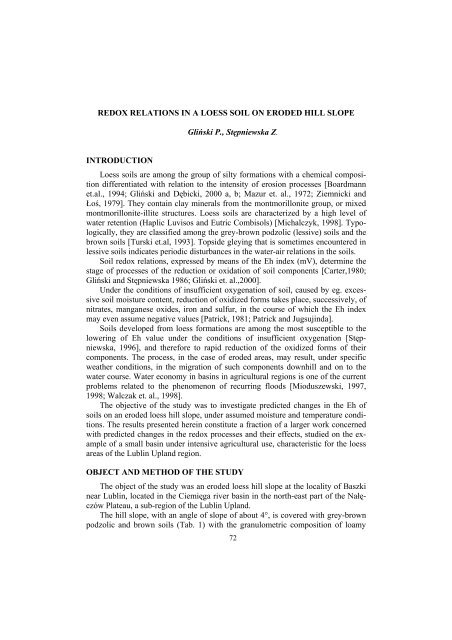soil - Lublin
soil - Lublin
soil - Lublin
You also want an ePaper? Increase the reach of your titles
YUMPU automatically turns print PDFs into web optimized ePapers that Google loves.
REDOX RELATIONS IN A LOESS SOIL ON ERODED HILL SLOPE<br />
Gliński P., Stępniewska Z.<br />
INTRODUCTION<br />
Loess <strong>soil</strong>s are among the group of silty formations with a chemical composition<br />
differentiated with relation to the intensity of erosion processes [Boardmann<br />
et.al., 1994; Gliński and Dębicki, 2000 a, b; Mazur et. al., 1972; Ziemnicki and<br />
Łoś, 1979]. They contain clay minerals from the montmorillonite group, or mixed<br />
montmorillonite-illite structures. Loess <strong>soil</strong>s are characterized by a high level of<br />
water retention (Haplic Luvisos and Eutric Combisols) [Michalczyk, 1998]. Typologically,<br />
they are classified among the grey-brown podzolic (lessive) <strong>soil</strong>s and the<br />
brown <strong>soil</strong>s [Turski et.al, 1993]. Topside gleying that is sometimes encountered in<br />
lessive <strong>soil</strong>s indicates periodic disturbances in the water-air relations in the <strong>soil</strong>s.<br />
Soil redox relations, expressed by means of the Eh index (mV), determine the<br />
stage of processes of the reduction or oxidation of <strong>soil</strong> components [Carter,1980;<br />
Gliński and Stępniewska 1986; Gliński et. al.,2000].<br />
Under the conditions of insufficient oxygenation of <strong>soil</strong>, caused by eg. excessive<br />
<strong>soil</strong> moisture content, reduction of oxidized forms takes place, successively, of<br />
nitrates, manganese oxides, iron and sulfur, in the course of which the Eh index<br />
may even assume negative values [Patrick, 1981; Patrick and Jugsujinda].<br />
Soils developed from loess formations are among the most susceptible to the<br />
lowering of Eh value under the conditions of insufficient oxygenation [Stępniewska,<br />
1996], and therefore to rapid reduction of the oxidized forms of their<br />
components. The process, in the case of eroded areas, may result, under specific<br />
weather conditions, in the migration of such components downhill and on to the<br />
water course. Water economy in basins in agricultural regions is one of the current<br />
problems related to the phenomenon of recurring floods [Mioduszewski, 1997,<br />
1998; Walczak et. al., 1998].<br />
The objective of the study was to investigate predicted changes in the Eh of<br />
<strong>soil</strong>s on an eroded loess hill slope, under assumed moisture and temperature conditions.<br />
The results presented herein constitute a fraction of a larger work concerned<br />
with predicted changes in the redox processes and their effects, studied on the example<br />
of a small basin under intensive agricultural use, characteristic for the loess<br />
areas of the <strong>Lublin</strong> Upland region.<br />
OBJECT AND METHOD OF THE STUDY<br />
The object of the study was an eroded loess hill slope at the locality of Baszki<br />
near <strong>Lublin</strong>, located in the Ciemięga river basin in the north-east part of the Nałęczów<br />
Plateau, a sub-region of the <strong>Lublin</strong> Upland.<br />
The hill slope, with an angle of slope of about 4°, is covered with grey-brown<br />
podzolic and brown <strong>soil</strong>s (Tab. 1) with the granulometric composition of loamy<br />
72

















